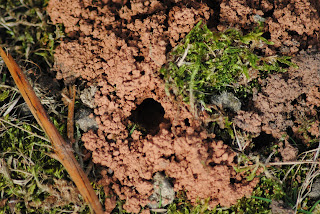This blog may help people explore some of the 'hidden' issues involved in certain media treatments of environmental and scientific issues. Using personal digital images, it's also intended to emphasise seasonal (and other) changes in natural history of the Swansea (South Wales) area. The material should help participants in field-based modules and people generally interested in the natural world. The views are wholly those of the author.
Sunday, 26 February 2012
Saturday, 25 February 2012
Saturday, 18 February 2012
Friday, 17 February 2012
Thursday, 16 February 2012
Wednesday, 15 February 2012
How to Grow a Planet- Growing Confusion?
The 'How to Grow a Planet' series on BBC TV is visually impressive and entertaining but it does not deal especially well with the concept of co-evolution (http://www.bbc.co.uk/iplayer/episode/b01c8b5t/How_to_Grow_a_Planet_The_Power_of_Flowers/). The second episode suggested that flowers had driven the development of colour vision in primates, by using colour to signify ripe fruit. One should note, additionally, that some uses of red mean poisonous rather than ready to eat. Even so, it is extremely unlikely that cones in the retina came about solely as a result of manipulation by flowers. Colour vision is important in other sets of circumstances (finding a mate and locating animal prey) and it is much more likely that the plant's signals and the primate detector systems drove each other in evolutionary terms.
Deer Oh Deer!
News from Washington DC that the authorities are going to use snipers to produce a mass cull of White-tailed deer in a major recreational park area (http://www.guardian.co.uk/environment/2012/feb/14/washington-deer-cull?INTCMP=SRCH). The Bambis stand accused of causing major damage to forested areas, including completely preventing regeneration by eating seedlings. Accommodating deer within such systems (a relatively small, confined space with no real predators) is difficult as the carrying capacity is likely to be very limited.
Saturday, 11 February 2012
Thursday, 9 February 2012
Tuesday, 7 February 2012
Same Old Song?
Scientists, led by a Montealegre Zapata, have reportedly re-created the song of a large bush cricket that lived in NW China 165 million years ago, in the Jurassic era (http://www.guardian.co.uk/science/2012/feb/06/mating-call-extinct-bush-cricket?INTCMP=SRCH). This large insect, it has been deduced from fossil evidence, would have produced a 6.4 KHz mating call, which would have been clearly in the human hearing range (many current bush crickets, like the one illustrated, produce calls nearer 20 KHz).
Sunday, 5 February 2012
Subscribe to:
Comments (Atom)
-
I n the UK and US, a pparently popular and successful vegan/vegetarian restaurants are reportedly closing or adding meat to their menus ( ...
-
Early ripening fruit may seem convenient but some folk think it confirms environmental stress. There's also a possibility th...










+2+standing+Chestnut+Centre+Derbyshire.jpg)





+lateral+leg+down+Oxwich.JPG)
+wading+Loughor.JPG)


%20mating%20NWCW.jpg)

